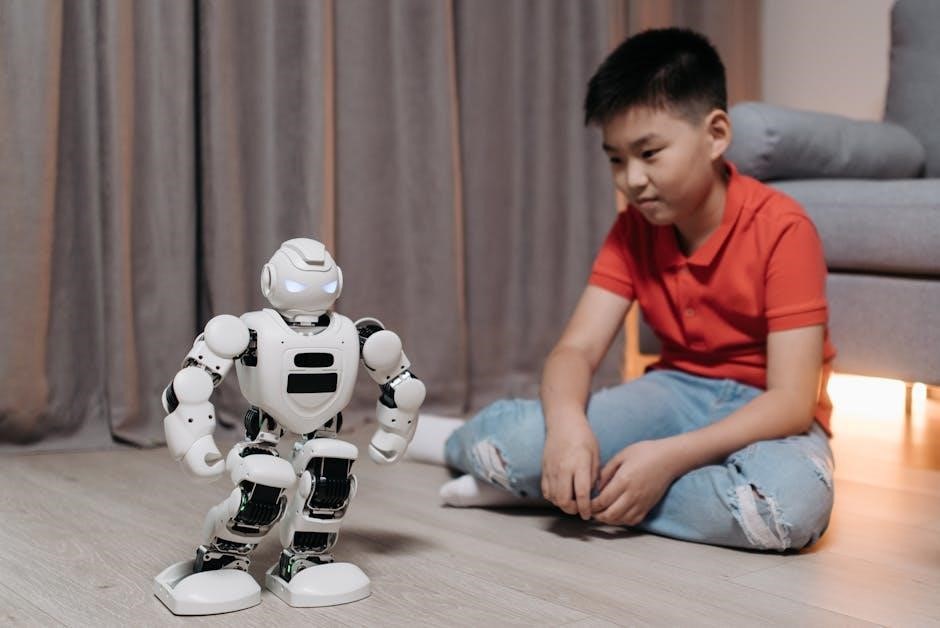Machine learning is a transformative technology enabling systems to learn from data, improving decision-making and automation. It powers advancements in AI, data analysis, and intelligent systems.
Overview of Machine Learning
Machine learning is a dynamic field within artificial intelligence that focuses on developing algorithms and statistical models to enable machines to learn from data. It empowers systems to make decisions, predictions, or recommendations without explicit programming. By leveraging patterns and insights from data, machine learning drives innovation across industries, from healthcare to finance. Researchers like Meng and Lee have significantly contributed to its advancement, exploring applications in additive manufacturing and organic synthesis. The field is divided into supervised, unsupervised, and reinforcement learning, each addressing unique problem types. As highlighted in resources like “Python Machine Learning” by Wei-Meng Lee, the technology continues to evolve, offering tools for solving complex challenges in data-driven environments. Its integration with IoT and distributed computing frameworks further underscores its transformative potential in modern technology.
Importance of Machine Learning in Modern Technology
Machine learning is a cornerstone of modern technology, revolutionizing industries by enabling systems to analyze data, identify patterns, and make informed decisions autonomously. Its applications span intelligent transportation systems, healthcare diagnostics, and organic synthesis, as highlighted in studies by Meng and Lee. By automating tasks and enhancing precision, machine learning drives efficiency and innovation. For instance, in additive manufacturing, ML optimizes production processes, reducing errors and improving outcomes. Similarly, in cyber threat detection, ML-based methods identify and mitigate risks in IoT networks. Resources like Wei-Meng Lee’s “Python Machine Learning” underscore its accessibility and versatility, making it indispensable for solving complex problems. As technology evolves, machine learning remains a critical enabler of advancements, ensuring smarter, faster, and more reliable solutions across diverse domains.

Key Concepts in Machine Learning
Wei-Meng Lee’s work highlights machine learning’s core concepts, including supervised, unsupervised, and reinforcement learning. These approaches enable systems to learn from data, driving advancements in AI and technology applications.
Supervised Learning
Supervised learning is a foundational approach in machine learning where models are trained on labeled data, enabling them to map inputs to specific outputs. This method is widely used for classification and regression tasks, leveraging algorithms like linear regression and decision trees. Wei-Meng Lee’s “Python Machine Learning” provides comprehensive insights into implementing these techniques, offering practical guidance for developers. The process involves feeding the model labeled data during training, allowing it to learn patterns and make predictions on new, unseen data. Applications range from predictive analytics to image classification, demonstrating its versatility. However, the reliance on high-quality labeled data presents challenges. Despite this, supervised learning remains a cornerstone in machine learning, driving advancements across various industries. Through resources like Lee’s work, developers can gain hands-on experience, enhancing their ability to apply supervised learning effectively.
Unsupervised Learning
Unsupervised learning is a machine learning paradigm where models are trained on unlabeled data to discover hidden patterns or intrinsic structures. Unlike supervised learning, it doesn’t rely on labeled outputs, making it ideal for exploratory data analysis. Techniques like clustering (e.g., k-means) and dimensionality reduction (e.g., PCA) are commonly used. Wei-Meng Lee’s “Python Machine Learning” provides practical examples of unsupervised learning, such as customer segmentation and anomaly detection. These methods are particularly useful when the data’s underlying relationships are unknown. Applications include image processing, gene expression analysis, and fraud detection. However, unsupervised learning requires careful interpretation of results, as the model doesn’t have predefined outputs to guide learning. Despite the challenges, it is a powerful tool for uncovering insights in complex datasets, making it a key area of study in machine learning.
Reinforcement Learning

Reinforcement learning (RL) is a machine learning approach where an agent learns to make decisions by interacting with an environment. Unlike supervised learning, RL doesn’t rely on labeled data but instead uses rewards or penalties to guide behavior. The goal is to maximize cumulative rewards over time, enabling the agent to learn optimal policies. Techniques like Q-learning and policy gradients are widely used. Wei-Meng Lee’s “Python Machine Learning” provides insights into RL applications, such as game playing and robotics. RL is particularly effective in dynamic, uncertain environments where explicit supervision is unavailable. However, challenges like the exploration-exploitation trade-off and high computational demands persist. Despite these hurdles, RL has revolutionized areas like autonomous systems and personalized recommendations, making it a cornerstone of modern AI research and development.

Applications of Machine Learning
Machine learning drives advancements in organic synthesis, intelligent transportation systems, healthcare diagnostics, and additive manufacturing. Wei-Meng Lee’s work highlights its role in solving complex, real-world challenges efficiently and innovatively.
Intelligent Transportation Systems (ITS)
Intelligent Transportation Systems (ITS) leverage machine learning to enhance road traffic management, public transportation, and driver safety. By analyzing real-time data from sensors and cameras, ML algorithms optimize traffic signal timings, reducing congestion and improving flow. Predictive maintenance for infrastructure, such as detecting potholes or bridge damage, ensures safer roads. ITS also enables smart routing, guiding drivers through less congested paths and lowering emissions. Wei-Meng Lee’s work highlights how Python-based ML solutions, like those in his book, can be applied to process large datasets for ITS, improving urban mobility and sustainability. These systems are vital for modern cities, offering efficient and eco-friendly transportation solutions. ML’s role in ITS underscores its potential to transform urban planning and commuting experiences globally.
Organic Synthesis and Chemical Reactions
Machine learning is revolutionizing organic synthesis by enabling the prediction of reaction outcomes and optimizing chemical selectivity. AI models analyze vast datasets of past experiments to guide chemists in synthesizing complex molecules. This approach accelerates the discovery of new materials and drugs by reducing trial-and-error processes. Wei-Meng Lee’s work highlights how ML algorithms can process chemical data to identify patterns, aiding researchers in designing efficient synthesis pathways. For instance, predictive models can suggest optimal reaction conditions, such as temperature and catalysts, to achieve desired outcomes. This integration of ML with organic synthesis streamlines workflows, reduces costs, and enhances precision. The use of ML in this field exemplifies its transformative potential in advancing scientific research and industrial applications, making it a cornerstone of modern chemical innovation.
Healthcare and Medical Diagnosis
Machine learning is transforming healthcare by enhancing medical diagnosis accuracy and efficiency. Algorithms analyze vast medical datasets to identify patterns, aiding doctors in detecting diseases early and accurately. For instance, ML can interpret imaging data, such as X-rays and MRIs, to detect abnormalities that may be missed by human eyes. Predictive analytics also enable personalized treatment plans by considering patient-specific factors. Wei-Meng Lee’s insights highlight how ML-driven tools assist in diagnosing conditions like cancer and cardiovascular diseases. Additionally, ML optimizes resource allocation in healthcare settings, reducing costs and improving patient outcomes. The integration of ML in medical diagnosis not only enhances clinical decision-making but also empowers healthcare providers to deliver more precise and timely care, ultimately saving lives and improving quality of life for patients worldwide.
Additive Manufacturing
Additive manufacturing, or 3D printing, leverages machine learning to optimize production processes and improve product quality. ML algorithms analyze vast datasets to predict material properties, ensuring precise printing parameters. Researchers like Meng and Lee highlight how ML enhances process control, reducing defects and material waste. Predictive models identify potential failures, enabling real-time adjustments. This technology accelerates prototyping and enables complex geometries, revolutionizing industries like aerospace and healthcare. By integrating ML, additive manufacturing achieves higher efficiency, customization, and scalability, driving innovation in manufacturing. Experts emphasize the transformative potential of ML in this field, paving the way for smarter, faster, and more sustainable production methods. The fusion of ML and additive manufacturing is reshaping traditional workflows, delivering cutting-edge solutions across various sectors.

Tools and Technologies in Machine Learning
Machine learning relies on tools like Python, TensorFlow, and Apache Spark. Wei-Meng Lee’s Python Machine Learning book provides hands-on training, while Spark enables distributed processing for large-scale models effectively.
Python Machine Learning
Python Machine Learning, as explored by Wei-Meng Lee, offers a comprehensive guide for developers to master machine learning techniques. Lee’s work emphasizes practical implementations, enabling coders to leverage libraries like scikit-learn and TensorFlow. Supervised learning methods, such as linear regression and decision trees, are thoroughly covered, providing foundational knowledge. The book also delves into advanced topics like deep learning and neural networks, making it accessible for both beginners and experienced programmers. Real-world applications, such as predictive analytics and natural language processing, are highlighted, demonstrating ML’s versatility. Lee’s approach ensures readers can apply ML concepts to solve complex problems efficiently. This resource is invaluable for anyone aiming to integrate machine learning into their projects, offering clear, hands-on guidance.
Apache Spark and Distributed Computing
Apache Spark, a powerful framework for distributed computing, plays a pivotal role in machine learning by enabling efficient processing of large-scale datasets. Its scalability and in-memory computation capabilities make it ideal for handling complex ML tasks. Spark’s MLlib library provides a wide range of algorithms for classification, regression, and clustering, simplifying the implementation of machine learning models. Distributed computing in Spark allows data scientists to train models on vast datasets across clusters, ensuring faster execution and better performance. Wei-Meng Lee’s insights highlight how Spark integrates seamlessly with Python and other tools, fostering a collaborative environment for data-driven projects. This combination of scalability and versatility makes Apache Spark a cornerstone in modern machine learning workflows, especially in applications like ITS and organic synthesis. Its ability to handle distributed data processing ensures robust and efficient model training, making it indispensable in today’s data-intensive world.
AI in Organic Synthesis
Artificial intelligence (AI) is revolutionizing organic synthesis by enabling the prediction of reaction outcomes and optimizing synthesis pathways. Machine learning algorithms analyze vast chemical datasets to identify patterns, accelerating the discovery of new compounds. AI-driven tools assist chemists in designing experiments, reducing trial-and-error processes and minimizing costs. Wei-Meng Lee’s work highlights how AI enhances precision in chemical reactions, ensuring higher yields and selectivity. This technology is particularly valuable in drug discovery and material science, where efficient synthesis is critical. By integrating AI with traditional methods, researchers can explore uncharted chemical spaces, leading to breakthroughs in fields like pharmaceuticals and advanced materials. The synergy between AI and organic synthesis promises to transform how chemicals are designed and produced, making the process faster, smarter, and more sustainable.

Real-World Case Studies
Cyber Threat Detection in IoT Networks
Machine learning algorithms detect cyber threats in IoT networks, enhancing security and efficiency. Wei-Meng Lee’s insights highlight how ML models identify anomalies, ensuring robust protection in connected systems.
Machine learning plays a crucial role in detecting cyber threats in IoT networks, where connected devices are increasingly vulnerable to attacks. Advanced persistent threats (APTs) pose significant risks, but ML-based methods offer robust solutions. By analyzing vast amounts of data, ML algorithms can identify patterns indicative of malicious activities, enabling timely interventions. Supervised and unsupervised learning techniques are commonly employed to classify threats and predict potential breaches. Real-world applications demonstrate ML’s effectiveness in mitigating risks, ensuring the security of IoT ecosystems. The integration of ML with IoT enhances resilience against evolving cyber threats, safeguarding sensitive data and maintaining network integrity. This approach is vital for protecting the growing number of connected devices in modern infrastructure.
Energy Efficiency in Organic Solar Cells
Machine learning is revolutionizing the development of organic solar cells (OSCs) by enhancing energy efficiency and power conversion rates. Researchers utilize ML algorithms to optimize donor:acceptor heterojunctions, a critical component in OSCs. By introducing a third component, such as non-fullerene acceptors, ML models predict and improve material properties, leading to higher efficiency. Supervised learning techniques analyze experimental data to identify optimal material combinations, while generative models design novel compounds; These advancements not only boost energy harvesting but also reduce production costs. ML-driven approaches accelerate the discovery of sustainable materials, making OSCs more viable for large-scale applications. The integration of ML in organic synthesis and device engineering ensures a greener and more efficient energy future, aligning with global sustainability goals.
Financial Modeling and Predictive Analytics
Machine learning has become a cornerstone in financial modeling and predictive analytics, enabling organizations to make data-driven decisions with precision. By leveraging historical data, ML algorithms predict market trends, stock prices, and customer behavior, reducing uncertainty. Techniques like supervised learning are widely used for regression and classification tasks, such as credit scoring and fraud detection. Python libraries, including scikit-learn and TensorFlow, are popular tools for building these models. Predictive analytics enhances risk assessment, portfolio optimization, and algorithmic trading, providing a competitive edge. ML also automates complex financial processes, improving efficiency and accuracy. With the integration of advanced ML models, financial institutions can uncover hidden patterns in data, leading to smarter investments and strategic planning. This application of ML is transforming the finance sector, enabling faster and more accurate forecasting.

Challenges and Limitations

Machine learning faces challenges like data quality issues, model interpretability, and scalability. Wei-Meng Lee highlights these limitations, emphasizing the need for robust preprocessing and transparent algorithms.
Data Quality and Preprocessing
Data quality is a critical factor in machine learning, as poor-quality data can significantly degrade model performance. Preprocessing steps such as cleaning, normalization, and feature engineering are essential to ensure datasets are accurate and relevant. Techniques like handling missing values, removing duplicates, and transforming data formats are common practices. Additionally, dimensionality reduction methods, such as PCA, help simplify data while retaining key information. Ensuring data quality involves addressing biases, outliers, and noise, which can mislead models. Proper preprocessing not only improves model accuracy but also enhances scalability and interpretability. Resources like Wei-Meng Lee’s works emphasize the importance of robust data preparation in achieving reliable machine learning outcomes, particularly in applications like additive manufacturing and organic synthesis, where precision is paramount.
Model Interpretability
Model interpretability is crucial for understanding how machine learning systems make decisions, ensuring transparency and trust in their outputs. Techniques like LIME and SHAP help explain complex models by identifying key features influencing predictions. Simplifying models or using interpretable proxies can enhance clarity without sacrificing performance. Interpretability is vital for debugging, validating, and complying with regulations, especially in sensitive fields like healthcare and finance. Resources such as Wei-Meng Lee’s works highlight the importance of balancing model complexity with explainability, enabling stakeholders to understand and trust AI-driven decisions. By prioritizing interpretability, developers can create more reliable and user-friendly machine learning solutions, fostering adoption across industries while maintaining ethical standards and accountability;
Scalability and Performance Issues
Scalability and performance are critical challenges in machine learning, particularly as datasets grow and models become more complex. Ensuring systems can handle large-scale data efficiently is essential for real-world applications. Apache Spark, discussed in resources like Wei-Meng Lee’s works, offers distributed computing solutions to tackle scalability issues. Optimizing algorithms and leveraging parallel processing can enhance performance, enabling models to train faster and scale across clusters. However, challenges like communication overhead and resource allocation remain, requiring careful tuning. Addressing these issues ensures machine learning solutions are both efficient and scalable, meeting the demands of modern applications and enabling broader adoption across industries. By focusing on scalability and performance, developers can build robust systems capable of handling the complexities of big data and high-performance computing environments.

Future Trends in Machine Learning
Future trends include integration with IoT, advancements in deep learning, and ethical AI governance. These innovations will enhance scalability, decision-making, and real-world applications across industries.
Integration with Internet of Things (IoT)
The integration of machine learning with the Internet of Things (IoT) is revolutionizing how smart devices operate and interact. By embedding ML algorithms into IoT systems, devices can analyze real-time data, enabling predictive maintenance, energy efficiency, and automated decision-making. For instance, in smart homes, ML-powered IoT devices can optimize energy consumption by learning usage patterns. Similarly, in industrial settings, ML-driven IoT solutions enhance operational efficiency and reduce downtime. Wei-Meng Lee’s work highlights the potential of ML in IoT, particularly in managing and interpreting large datasets generated by connected devices. This synergy between ML and IoT is driving innovation across sectors, from healthcare to transportation, creating smarter and more responsive systems. As IoT expands, the role of ML in enabling intelligent, data-driven solutions will become increasingly critical.
Advances in Deep Learning
Deep learning, a subset of machine learning, has seen remarkable progress, driven by advancements in neural networks and computational power. Techniques like convolutional neural networks (CNNs) and recurrent neural networks (RNNs) are enabling breakthroughs in image recognition, natural language processing, and autonomous systems. Researchers and practitioners, including Wei-Meng Lee, have contributed to these developments, exploring innovative applications and optimizations. The integration of deep learning with IoT and big data analytics is further enhancing its capabilities, making it a cornerstone of modern AI. As deep learning continues to evolve, it promises to solve complex problems across industries, from healthcare to finance, driving technological innovation and transforming how we interact with data and systems. These advancements underscore the pivotal role of deep learning in shaping the future of machine learning and artificial intelligence.
Ethical Considerations and AI Governance
Ethical considerations and AI governance are critical as machine learning becomes pervasive in society. Issues like bias, transparency, and accountability must be addressed to ensure responsible AI deployment. Wei-Meng Lee’s work highlights the importance of ethical practices in machine learning, emphasizing fairness and privacy. As AI systems impact decision-making across industries, robust governance frameworks are essential to mitigate risks and ensure alignment with societal values. Researchers and organizations must prioritize ethical guidelines to build trust and prevent misuse. These considerations are vital for fostering a future where AI benefits humanity while minimizing harm. By integrating ethical principles into AI development and deployment, we can create systems that are not only powerful but also just and accountable, ensuring a balanced approach to technological advancement and human well-being. Ethical AI governance is thus a cornerstone of sustainable innovation in machine learning.
Machine learning, as explored by Wei-Meng Lee, has revolutionized industries, offering insights and automation. Its evolution promises continued innovation, shaping a future where technology and ethics harmonize for societal benefit.
Machine learning is a dynamic field revolutionizing industries through data-driven insights. It enables systems to learn, adapt, and make decisions autonomously, powering advancements in AI and automation. Applications span intelligent transportation systems, healthcare diagnostics, and organic synthesis, leveraging tools like Python and Apache Spark. Wei-Meng Lee, a prominent technologist, has contributed significantly to machine learning education, emphasizing practical implementation. Challenges include data quality, model interpretability, and scalability, while future trends focus on IoT integration and ethical AI governance. This field continues to evolve, offering transformative solutions across diverse domains, with resources like Lee’s works providing foundational knowledge for practitioners. The integration of machine learning into everyday technologies underscores its pivotal role in shaping the future of innovation and problem-solving.
Final Thoughts on Machine Learning
Machine learning represents a paradigm shift in how technology interacts with and processes data, driving innovation across industries. Its ability to enable systems to learn and adapt autonomously has unlocked unprecedented opportunities for automation, personalization, and decision-making. As highlighted by thought leaders like Wei-Meng Lee, the field emphasizes practical implementation, making it accessible to developers and researchers alike. The integration of machine learning with emerging technologies, such as IoT and deep learning, promises to further accelerate progress. However, ethical considerations and governance must remain central to its advancement. By addressing challenges like data quality and model interpretability, machine learning can continue to transform industries, fostering a future where intelligent systems enhance human capabilities while maintaining trust and accountability.

References
Key resources include academic papers, books, and online courses on machine learning, such as Wei-Meng Lee’s “Python Machine Learning” and research articles on ML applications.
- Wei-Meng Lee, “Python Machine Learning.”
- Meng et al., “Machine Learning in Additive Manufacturing.”
- Academic journals on AI and ML applications.
Academic Papers and Journals
Academic papers and journals play a crucial role in advancing machine learning research. Wei-Meng Lee, a prominent technologist, has contributed significantly to the field through his works. His book, Python Machine Learning, is widely recognized as a comprehensive resource for developers. Research papers like “Machine Learning in Additive Manufacturing: A Review” by Meng et al. explore ML’s applications in manufacturing. Journals such as the Journal of Machine Learning Research and International Journal of Data Science publish cutting-edge studies. These resources provide insights into ML algorithms, applications, and innovations, making them essential for researchers and practitioners alike. Accessing these papers in PDF format is convenient, enabling widespread dissemination of knowledge.
Books and Online Resources
Books and online resources are invaluable for mastering machine learning. Wei-Meng Lee’s Python Machine Learning is a popular book that equips developers with practical skills in machine learning. Available in PDF and ePUB formats, it covers essential concepts like supervised learning and neural networks. Online platforms offer a wealth of resources, including tutorials, webinars, and GitHub repositories. Developer Learning Solutions, founded by Wei-Meng Lee, provides hands-on training materials; These resources cater to coders of all levels, from beginners to advanced practitioners. They emphasize real-world applications, making machine learning accessible and actionable. By leveraging these books and online tools, learners can gain a deep understanding of machine learning and its implementation in various fields, fostering innovation and skill development in the tech community.